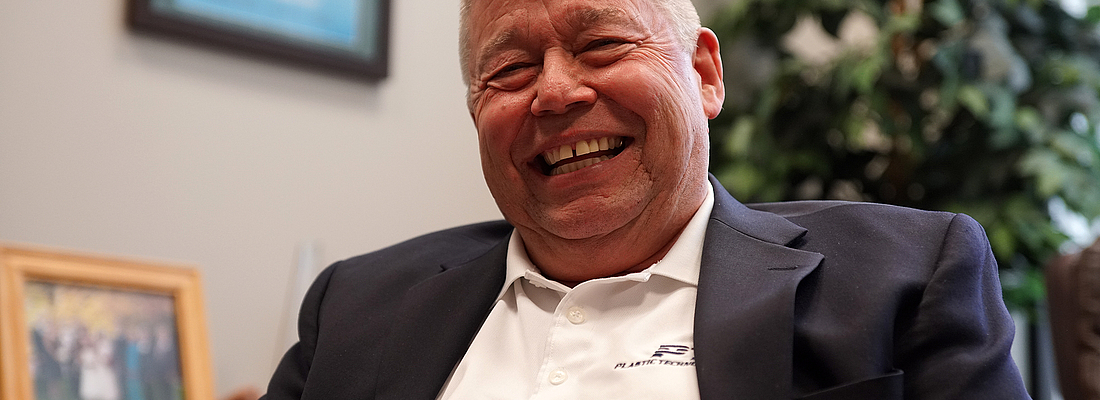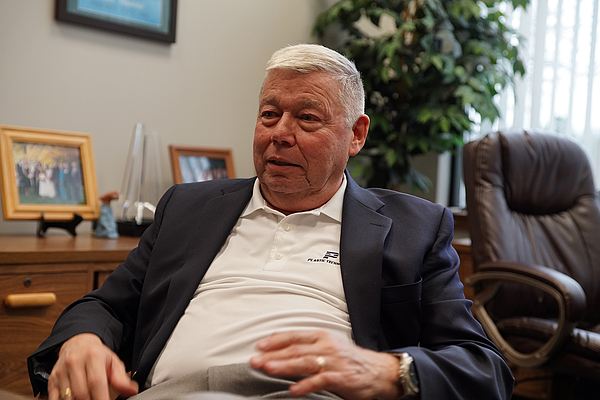

“Today I can say that the secret of my success has been to hire smart people and to get out of their way.“
An interview with Dr Tom Brady, Chairman and Founder of Plastic Technologies, Inc. (PTI) about founding and managing a packaging technology company.
Tom, it has been many years since we met last. How time flies.
You are right. Everything is moving so rapidly now and no business can exist without changing. When I started PTI back in 1985, there were perhaps only 10 people in the world that knew what I knew about PET bottle technology. But today, there are thousands of people and hundreds of companies that know some of what we know at PTI. To remain viable, every company and every company leader must remain current and must find new ways to service customers.
Does rapidly moving technology also offer advantages, and doyou still like the challenges?
Oh, yes, absolutely. Just recently we started up a joint venturemanufacturing company to make medical products. And, whilewe are not experts in medical products, most medical productsand devices are made from plastics. We know plastics, weknow processing of plastics, we know how to commercialiseproducts, and we know how to design plastic products - so weare hopeful that this new venture will be successful. However,there is no guarantee of success when you embark on a newopportunity like this, but, finding new opportunities is one ofthe reasons it is so important to think outside of the little boxthat you work in every day. The answer is definitely “Yes,” Istill like these new technical and commercial challenges.

Please tell me more about how to step out of the little box today.
I find that sitting on different boards gives me a broad andcurrent perspective. I sit on plastics organisations boards,university boards, and community and cultural organizationboards. Being on the University of Toledo Medical Collegeboard provided me, for example, with the opportunity to meeta spinal surgeon who is not just a spinal surgeon, but whois also an inventor. Once we got to know each other and helearned that I was involved in the plastics industry, he askedwhether PTI was interested in making the medical products hewas inventing. In fact, I never would have met this gentleman,if I had not been sitting on this board and if I had not gotteninvolved in a conversation about making plastic medicaldevices.
Do you think our engineers today are too focused on specific projects?
I think about this topic very often and I find myself asking,“Do we teach our students the right subjects and do we giveour young engineers broad enough exposure to differentproject assignments?” When you and I began working in thisindustry, we had the opportunity to meet many differentpeople in many different companies around the world. Today,I worry that our young engineers are not getting this earlyand broad exposure to everything from technology, to sales,and to manufacturing. Indeed, there is a tendency today tobe less flexible when it comes to job assignments, and often, Ifind myself wishing that our young engineers had the chanceto learn and mature more like we did, when we had no ideawhat was coming next, and when we had no choice but to beprepared for new challenges.I also attribute my flexibility and success today to the fact thatI had a different kind of engineering education. In contrast tomost engineers, I attended a liberal arts college where, insteadof earning a standard Bachelor of Science in Engineeringdegree, I received a Bachelor of Arts degree with a major inengineering. The difference for me was that, while I probablyhad fewer engineering courses than did my friends who wentto MIT and Michigan, I took courses in everything from artand philosophy to psychology and the humanities, and I thinktaking these courses taught me better how to think criticallyand creatively.Of course, I also took many engineering courses, but myliberal arts education gave me a different and, I think, moreinteresting platform to start from.

Do you think that we in the plastics industry don’t give these young people enough time to do different things?
One of the things I find myself saying when I speak publiclyis that today’s world is so full of legal issues that parentsmust be almost too careful about letting their kids grow upby experimenting and by making mistakes. While I think that Igrew up with really good parents, I also think that my parentswould risk being arrested today for the way they brought meup. For example, my father would bring home everything fromelectric motors to chemicals and would turn me loose in ourbasement to build things and to experiment, with essentiallyno supervision. While parents today might be accused ofchild endangerment, if they did what my parents did with me,I also think that learning on my own, in my basement, andby experiment helped me to become a much more creativeand capable engineer. Today, I find that many beginningengineering students have never even had to fix their ownbicycles, let alone having to rebuild an automobile engine,which I did as a high school student.
What is the right way to teach engineering students to be creative and entrepreneurial?
My answer to that question is to model engineeringprogrammes after the engineering programme I went throughat Dartmouth College, where the first engineering course is not a technical engineering course. Rather, students aredivided into teams, given a practical problem to solveand told to “act like companies” with the goal of solvingthe problem and then marketing and selling the solution.Thus, before students at Dartmouth become immersedin the details of engineering, they learn very quickly howto work as teams, how to solve real world problems, howto economically build prototypes, and how to integratetechnology with the real world.Recently, I have spent time at the University of Toledohelping the College of Engineering to create a similarprogramme.I also find myself promoting the idea of learning creativityoutside of the engineering curriculum. For example,art is an inherently creative activity and learning to becreative in art courses allows an engineer to also becreative in the world of engineering.

Do you think younger engineers have the same fascination for engineering and technology today as we did 30 years ago?
No question ... There is still a fascination withunderstanding and creating new technologies. Oneexample is computer simulation and modeling where,in principle, we are able today to put a material in themachine on a computer, simulate the production of apreform, simulate the blow moulding of that preforminto a bottle shape, and then by knowing how thatmaterial was formed, we are able to simulate the relevantproperties of that bottle and thus we are able to actuallypredict the performance of that bottle in the real world,all on a computer. Our engineers are as excited andfascinated doing this computer simulation and modeling,as you and I were when we formed and tested the firstPET bottles on laboratory machines, 40 years ago.I well remember breaking new ground with the first BAB-3 rotary blow-moulding machine that O-I developed withCorpoplast back in 1975 and I remember Peter Rose andI running around the machine trying to make the darnedthing work. Today, we trouble-shoot machinery using ourcell phones and simulate machine performance usingcomputers ... What a different world we live in today!
Can the engineers from our generation still help create new technologies, or are we living in a new world where only the younger “digital natives” can operate?
That’s a good question and I guess the short answer is“I don’t know.” You and I grew up in an analogue world,which was very different from the digital world of today.Nevertheless, I do think that our past experience in creating,innovating, and managing success does have an importantplace in the new digital world. For example, I was asked tobecome the Interim Dean of Education at the University ofToledo several years ago and I think it is fair to say that I waspretty successful, not because I was a professional educatorand not because I was hands-on familiar with the new digitaleducation tools of today. Rather, what I brought to this rolewas the ability to analyse, think, create, and to lead; all skillsthat I learned as an engineer in the analogue industrial worldover many years. I might also point out that the young PTIengineer who is starting up our medical products company isabout the same age as I was when I founded PTI. He is usinghis engineering skills to learn the medical products business,and he is more excited than he has ever been, just to havethe chance to create a new enterprise. At the end of the day,leadership must keep people engaged and excited.I should also point out that gender equity has also changedover the last 30 years. Half of our engineers at PTI are nowfemale; when you and I went to school, there were only a fewwomen in the engineering programmes.I can also report that over the 30 years since I founded PTI,turnover of our professional staff, male and female, has beenextremely low, which I also think speaks to the fact thattoday’s younger engineers are excited about what they canaccomplish and about the future.
Where do you see the challenges for the future?
One thing that is becoming increasingly clear is that manycompanies, especially smaller companies, can no longer affordto have all the equipment, services, and people internallythat are required to satisfy customers who are increasinglydemanding and who want both improved timing and moreinnovation. This means that, increasingly, companies areentering into partnerships, alliances, or joint ventures in orderto develop new products and to supply those new products.My view is that if a partnership or alliance can satisfy acustomer’s needs, then that becomes a win-win situationfor the cooperating partners, because the customer doesnot really care who provides what. All the customer wants iseffective and economical results.PTI, for example, has established a joint venture testinglaboratory in India, and while it is still too early to judgesuccess, we like that model because it leverages the strengthsof both parties.I am also reminded that companies like PTI are increasinglyleveraging their various businesses by working closelytogether to provide a competitive advantage, rather thanoperating as completely separate business units.

What is different between the USA and Europe with regard to packaging?
The most significant European packaging trend is thatEuropeans are focused on reducing packaging materials andthis trend has been accompanied by an emphasis on “green”packaging and on the recycling of packaging.Recycling of packaging is also driven by the higher cost of wastedisposal in Europe but the advanced recycling infrastructurein Europe is also due, in part, to Europe’s willingness to passlegislation to enforce recycling.Regarding specific packaging materials, polyvinyl chloride(PVC) is completely out in Europe but still persists here in theUS.Finally, my sense is that packaging technology is moreadvanced technically in Europe and one example is that PTI’sexpertise in thin wall and capsule packaging is more advancedat our PTI-Europe company than at our PTI-US company.
Thank you very much for your time and talking to us.
The comPETence center provides your organisation with a dynamic, cost effective way to promote your products and services.

magazine
Find our premium articles, interviews, reports and more
in 3 issues in 2026.



